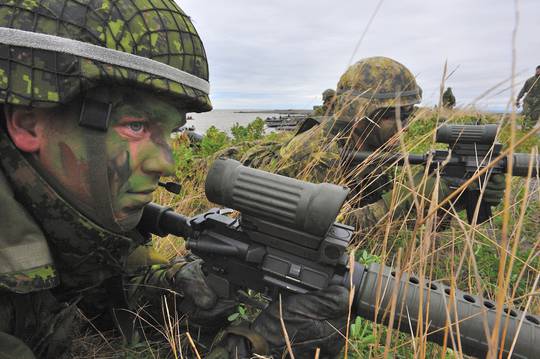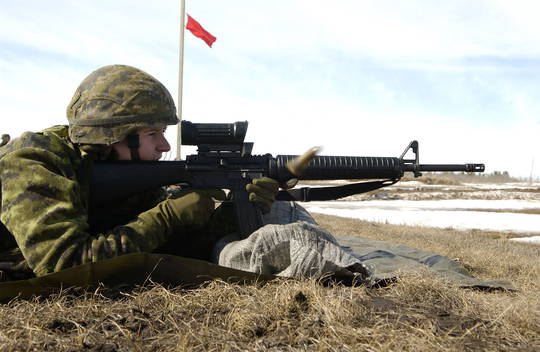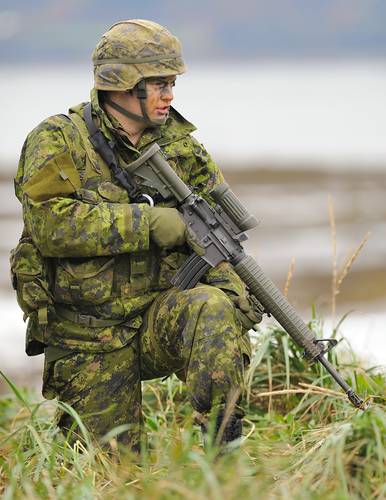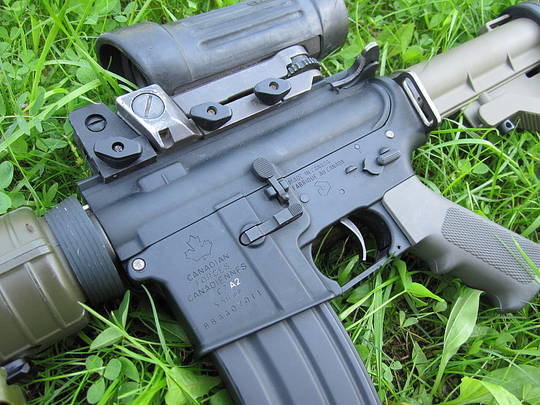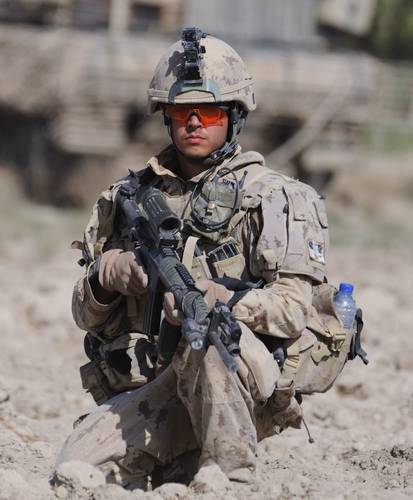[ This guest post was written by CanadianSoldier ]
The M-16 rifle is one of the most iconic firearms of all time, becoming well-known as the standard service weapon of the United States and its allies. But few know about the M-16′s close relative, the Canadian-made C7 rifle and C8 carbine, which is in service with the armed forces of Canada, Norway, Iceland, Denmark, and the Netherlands.
The C7 rifle in Canadian service has gone through several updates, similar to the progress of the M-16 in US service. The rifle entered service with the Canadian Army in the early 1980s as a replacement for the FN-FAL (FN-C1 in Canadian service) rifle at the conclusion of the Small Arms Replacement Program (SARP). They were produced in Canada by Diemaco, under license from Colt. Diemaco has since been bought out by Colt, and is now known as Colt Canada.
The original rifle, the C7 in Canadian service, was essentially an M-16A2 with a few changes. The C7 had an M-16A1 profile carry handle, is capable of fully-automatic fire, and had a cold hammer forged barrel. Diemaco also produced a proprietary M-203 40mm grenade launcher mount for the C7 family, which came as a replacement for the lower handguard.
C7s were initially issued with Thermold plastic magazines, intended to be discarded on the battlefield after use. However, the Thermold magazines were being re-used and led to malfunctions due to excessive wear. Eventually they were replaced in service by NATO-standard steel magazines.
In 1990, the C7 was superseded in Canadian service by the C7A1, which incorporated a new, railed upper receiver. The new receiver incorporated a weaver-style rail with 14 slots (a Mil-Std 1913 rail has 13 slots). C7A1s were issued with an Elcan C79 3.4x optic and a plastic backup iron sight. C7A1s were also given the Accu-Wedge, which was meant to make the receivers close up tighter to improve accuracy. With the C79 sight in service, marksmanship scores increased significantly, and the shooting qualification tests were revised as a result. The C79 is nitrogen-purged, with a tritium aiming point to give an aiming reference in low light conditions. Adjustments for windage and elevation are done externally via the scope mount.
Both the C7 and C7A1 had a fixed stock, and a slightly shorter stock was available for smaller-framed soldiers. Around the year 2000, the Army decided to begin a midlife update for the C7A1 to address some shortcomings with the platform. Although the C7A1 had served well in a number of theatres, feedback had been collected and some issues were highlighted. Complaints were focused on the bulk of the rifle, especially when operating from vehicles, as well as an inability to easily mount accessories. In Kosovo, some units were given the KAC M5 RAS for evaluation. These were well-received by the soldiers, but as a cost-cutting measure, the M5 RAS was not incorporated into the final C7A2 design. Complaints were also levelled at the C79 sight, which had a tendency to lose zero due to a poorly designed mount. A number of drop-in changes would be added to make the rifle more ambidextrous for left-handed soldiers.
The C7A2 is created in batches from C7A1s that are sent back to Colt Canada for the service. Regular Force army units were the first to receive the -A2s, with units going overseas getting priority. From there, Army Reserve units in the Combat Arms (Infantry, Armour, Engineers and Artillery) would receive them. It’s unclear at this point whether all C7A1s will be given the update Army-wide. Navy units still use the C7, and it’s unlikely they will receive the upgrade.
This is a list of changes made to the C7A1 to create the C7A2:
- Upper receiver gets re-blued, with a new barrel and front sight gas block + tube assembly.
- Charging handle replaced with a ‘tactical’ model designed to be easier for left-handed soldiers to operate
- Black handguards are replaced with green-coloured ones with new aluminium heat shields to replace worn-out ones.
- A removable Mil-Std 1913 rail attachment system called TRI-AD (TRIple Aiming Device) is mounted under the front sight, directly on the barrel.
- Lower receiver gets a carbine-length recoil buffer tube, along with a green-coloured 4-position buttstock.
- Black pistol grip is changed for a green-coloured model, some come with an Otis GripKit.
- A sling attachment point is added to the left side of the receiver end plate.
- A Diemaco-branded ambidextrous magazine release button is added to the lower receiver, identical to the Norgon Ambi-Catch.
- An ambidextrous fire-selector switch is added to the lower receiver.
- The C79 sight is replaced with the C79A2 model, which incorporates green-coloured rubber instead of black, as well as a new mount. The mount incorporates a spring designed to reduce zero shift issues.
- A new bayonet is issued with each C7A2, made by Eickhorn-Sollingen, to replace the Nella bayonet. The new bayonet includes a scabbard with integrated sharpening stone. The scabbard and bayonet are designed to lock together through a lug, to enable the bayonet to cut wire.
To take advantage of the TRI-AD, infantry soldiers are usually issued with a laser aiming device / illuminator, such as the AN/PEQ-2 or AN/PAQ-4, in addition to an Insight M3X weapon light. Rifles are also occasionally issued a drop-in Picatinny rail kit to mount a Cadex folding vertical grip.
[ Many thanks to CanadianSoldier for writing this interesting article. ]
 Your Privacy Choices
Your Privacy Choices
